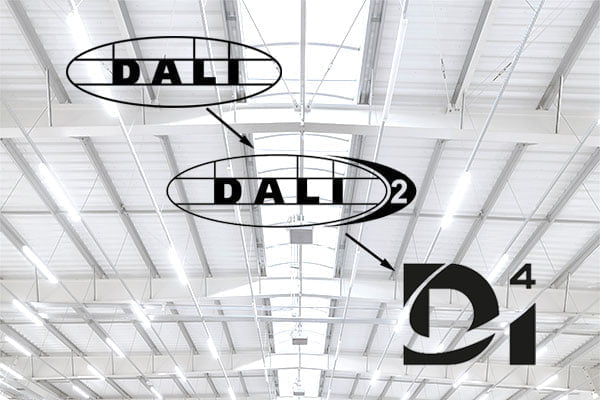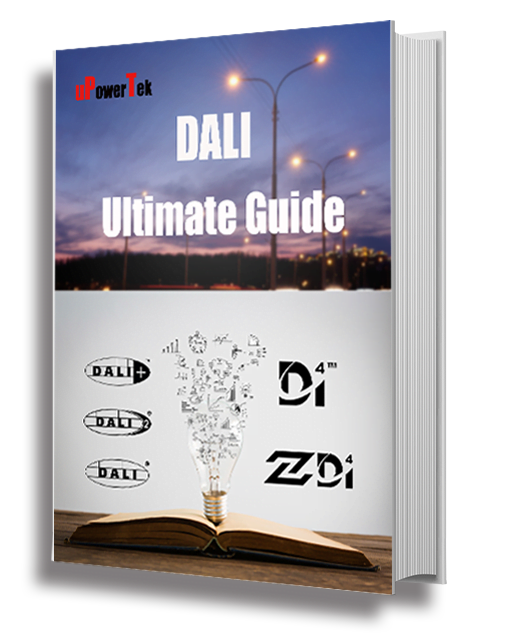D4i is the new DiiA specifications that define DALI protocol in the IoT(Internet of Things) era.
A DALI expert would argue that D4i would perfectly work for intra-luminaire DALI.
Should we expect this to be the case? And what does an intra-luminaire define?
Let’s find out below, including how D4i differs from other DALI versions.
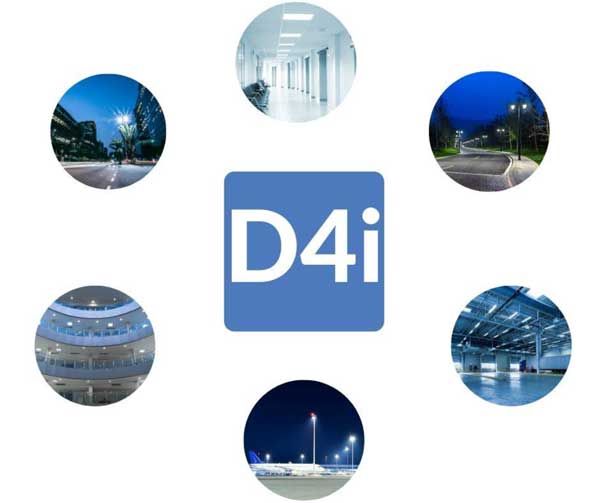
What is DiiA
DiiA is another name for DALI Alliance, and it defines an open, global consortium of lighting companies. Its main goal is to develop and grow a market for lighting-control solutions in line with the standardized Digital Addressable Lighting Interface (DALI) protocol.
The DALI Alliance came into existence in 2017 to industry requests for DALI-2. DALI-2 is an upgrade of DALI version 1, and it is an independently-verified Certification program. This certification program brings with it the promise of significantly improved interoperability and additional functionality, unlike the previous version.

Now you’re wondering, does DiiA have anything to do with D4i? Pretty much, D4i represents the most recent works of the DALI Alliance that applies mainly on the DALI-2 intra-luminaire (more on this below) and supports DALI in the IoT era. Therefore, here’s how the 3 DALI versions differ when it comes to DiiA:
- DiiA was born before DALI-2 and D4i but after DALI version 1 since DALI-1 was established in the ’90s. However, DiiA continues to handle trademarks that apply to all three.
Background Information of D4i
History of DALI
DALI was developed in late 1990 to meet market needs for lighting control that is digital and flexible. It was then defined by the IEC (International Electronic Commission) in IEC60929. It has grown immensely to embody D4i (DiiA specifications), which supports DALI in the IoT era.
DALI version 1 only had the luminaire (LEDs + led Driver), DALI bus, Bus power supply unit, and input devices (switches).
There were no control devices, and the devices that were used then as such were proprietary, and they had no DALI version-1 trademarks. Furthermore, their bus power supplies did not require apparent tests before use, and as such, they were not allowed to use DALI version-1 trademarks. Therefore any control device/bus power supply that came before DALI-2 is not allowed to use the DALI version-1 trademark.

For control gears to have the DALI-1 logo, they should:
- Be registered/listed on the official DALI website
- Have passed the DALI version 1 tests
Invent of DALI-2
DALI version 2 builds on DALI version 1 by adding control devices, application controllers, more features, and more importantly, it’s an independently-verified certification program. DALI-2 products are required to undergo a rigorous test procedure, and the test results are independently verified by DALI bodies to confirm that they meet the required protocols.
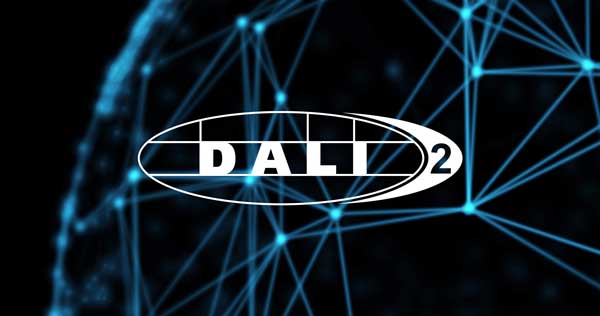
The testing procedure involves regular Plug fests, which are events organized by DiiA, to allow their member companies to test the interoperability of their products with those from other manufacturers. The DALI certification program significantly improves interoperability and adds functionality to the previous DALI-1 version.
Products are allowed to carry the DALI-2 certification program after they have passed the above test protocols, with verification by DiiA. This certification methodology not only ensures standards, but also promotes interoperability between DALI-2 led drivers and their controllers.
DALI-2 comprises of two main applications:
Inter-luminaire also Traditional
The DALI bus connects a series of luminaire, distributed throughout a building.
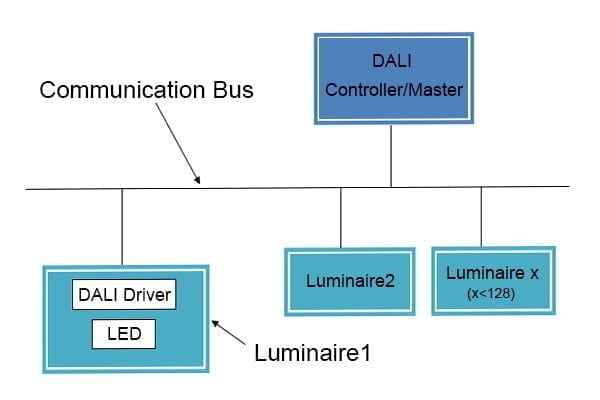
Intra-luminaire DALI-2
This features a DALI-2 bus that does not leave the luminaire but instead connects to a sensor/wireless radio within the luminaire. This sensor communicates to other networks. The D4i power supply specifications focus mainly on this intra-luminaire DALI-2 below:
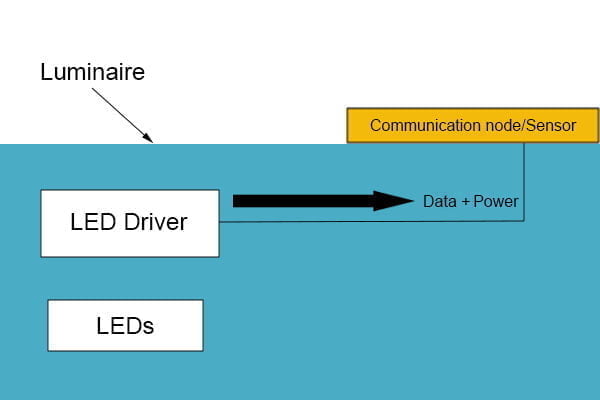
by enabling smart LED drivers and luminaires that can report a wide range of operational, diagnostic, and inventory data. IoT is further possible with the addition of power supply specifications that simplify the addition of sensors and wireless communication nodes to luminaires.
Note that: the D4i power supply specifications focus mainly on intra-luminaire DALI-2.
D4i now comes with:
Power Supply Specifications
It entails:
- DALI Part 250 allows for Integrated Bus Power Supply within the control gear e.g. the LED drivers that can power devices such as the sensors on the bus. This PSU can be enabled or disabled for systems with multiple bus PSUs. However, D4i certification requires that this 250 part must be included with the bus PSU enabled by default.
- DALI Part 150 is for AUX Power Supply. This part allows for a 24V DC power supply that can be built into the control gear or designed as a standalone product. It is suitable if you have devices that demand high-power requirements, for example, city-wide wireless transceivers. Its maximum wattage is 6W.
D4i data Specifications for Control gear
D4i now comes with DALI memory banks that store data in standardized format and locations. Such data allows you to define your enhanced asset management and performance monitoring. The data entails:
- DALI Part 251 for Luminaire data. You can access information on your luminaire, for example, ID code, light output, CCT & CRI, and light distribution from the control gear, and decide how to manage your assets.
- DALI Part 252 for Energy Reporting. You can access real-time data on power and energy usage for your control gears.
- DALI Part 253 – Diagnostics and Maintenance. Predictive maintenance is now possible from real-time data for control gear and lamps. This data includes failure conditions and run-time data.
Note: To get a D4i certification on your Control gear, it should implement Part 250 and Part 251-253. Part 150 is optional.
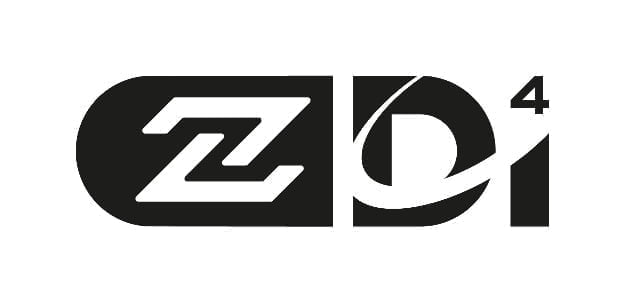
D4i Specifications for Control devices
Comes with:
- DALI Part 351 for luminaire-mounted control devices. This part specifies four control devices (1-4) that can be bus-powered or powered externally using the AUX power supply.
- Multi-master application controller with/without sensor. Externally powered
- Multi-master application controller with/without sensor. It’s externally powered or bus-powered.
- Multi-master application controller optionally with sensor, bus-powered.
- Single-master application controller optionally with sensor, bus-powered or externally powered.
This part also defines other scopes for these control devices such, as:
- Requirements for power consumption
- A mechanism to arbitrate between multiple application controllers
- A memory bank definition for multi-master devices
Remember: To get a D4i certification on your control device, it should implement part 351.
Comparison of DALI, DALI-2, and D4i
Features Exclusive to D4i
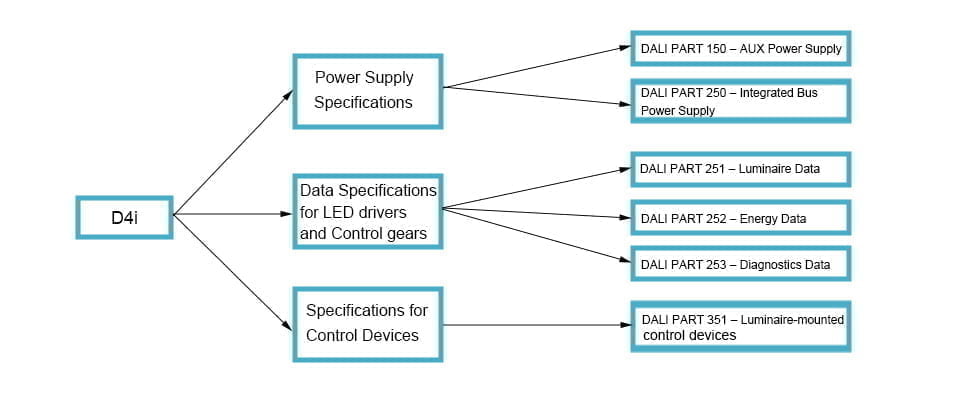
Comparisons in the Features and specifications for DALI, DALI-2 and D4i
D4i also DiiA specifications, build on DALI-2 certification. DALI-2 can work without D4i, but D4i cannot work without DALI-2. Therefore let’s examine how these parts and specifications differ among the three and how D4i builds on DALI-2.
General Requirements
| IEC 62386 Part | Status | Applicable to DALI-1 testing | Applicable for DALI-2 Certification | Status for D4i |
|---|---|---|---|---|
| 101- System | Aligned to DALI-2 | Yes | Yes | Builds on DALI-2 |
| 102 – Control Gear | Aligned to DALI-2 | Yes | Yes | Adds more features to DALI-2 |
| 103 – Control devices | Aligned to DALI-2 | No | Yes | Adds more features to DALI-2 |
Specific Requirements for Control Gear
| IEC 62386 Part | Status | Applicable for DALI-1 Testing | Applicable for DALI-2 Certification | Status for D4i |
|---|---|---|---|---|
| 201 – Fluorescent Lamps | Aligned to DALI-2 | Yes | N/A | N/A |
| 202 – Self Contained Emergency | Update for DALI-1 in progress | Yes | Yes | Yes |
| 203 – HID lamps | Aligned to DALI-1 | Yes | N/A | N/A |
| 204 – Low voltage halogen lamps | Published as DALI-1 | Yes | N/A | N/A |
| 205 – Incandescent lamp dimmer | Published as DALI-1 | Yes | Yes | Will build on DALI-2 |
| 206 – Conversion to DC ( 0/1-10V) | DALI-1 published | Yes | Yes | Therefore will build on DALI 2 |
| 207 – LED modules | DALI-2 Aligned | Yes | Yes | Applicable to DALI-2 |
| 208 – Switching | Published as DALI-1 | Yes | Yes | Will build on DALI-2 |
| 209 – Color Control | Published as DALI-1 | N/A | Yes | Will work on DALI-2 |
Specific Requirements for control/Input devices
| IEC 62386 Part | Status | Available for DALI-1 testing | Applicable for DALI-2 certification | D4i status |
|---|---|---|---|---|
| 301 – Push buttons | DALI-2 aligned | N/A | Yes | Will build on DALI-2 |
| 302 – Absolute input devices | DALI-2 aligned | N/A | Yes | Will build on DALI-2 |
| 303 – Occupancy sensors | DALI-2 aligned | N/A | Yes | Will work on DALI-2 |
| 304 – Light sensor | DALI-2 aligned | N/A | Yes | Builds on DALI-2 |
DiiA specifications
These are the D4i new features and they do not apply to DALI version 1.
| Type | DALI part | Status | Available for DALI-2 certification | Available for D4i certification |
|---|---|---|---|---|
| AUX Supplies | 150- AUX power supply | Published | Yes | Yes |
| Control gear – LED drivers | 250 – Integrated Bus Power Supply | Published | Yes | Yes |
| Control gear – LED drivers | 251 – Luminaire data | Published | Yes | Yes |
| Control gear – LEDs | 252 – Energy data | Published | Yes | Yes |
| Control gear – LEDs | 253- Diagnostics and maintenance | Published | Yes | Yes |
| Control devices | 351- Luminaire mounted control devices | Published | Yes | Yes |
Differences in the way they handle the testing and Certification
| DALI Version 1 | DALI Version 2 | D4i | |
|---|---|---|---|
| Testing Procedures | Compliance testing is based on self declaration by manufactures. Test results are not independently verified by DiiA. | Involves a verification step to confirm that test results are correct and successful. Testing makes use of ProbitLab2 | Testing is an extension of DALI-2 ,using ProbitLab2 |
| Certification | DALI-1 logo is available for registered control gears (drivers) that have passed the DALI-version 1 tests and are listed on DALI website. | DALI-2 certification is available to certified products that have passed the DALI-2 tests, with verification by DiiA. | D4i certification is available to products that have passed DALI-2 tests, implement the new DiiA specifications, with verification by DiiA. |
| Product displays on website | Yes | Yes | Yes |
| New DiiA specifications | Not applicable | Optional, meaning that you can get a DALI-2 certification without implementing these new parts | Required to implement the new specifications to get a D4i Certification. DALI part 150( AUX power supply) is optional |
Introduction of D4i Certification
D4i is an extension of DALI-2 certification with mandatory new specifications. For a device i.e. control gear or a control device to have the D4i certification it must meet the requirements for the DALI-2 certification. After meeting such requirements, it has to implement the new D4i mandatory features such as:
- D4i drivers must implement part (250) and part (251-253) of DALI that defines the power supply specifications and data specifications for control gears respectively.
- D4i control devices must include part 351 that further standardizes the control devices.
Part 150 for AUX Power Supply is optional for the D4i certification. You can decided to implement it or not without being denied the certification. The D4i certification on DALI-2 products that meet the new specifications is done by the DALI Alliance also DiiA.
D4i certification allows you to use the D4i trademarks. However these trademarks and certification are only available to DiiA members.
The Difference between ZHAGA –D4i and D4i
Zhaga-D4i certification is a joint program that is based on intra-luminaire DALI that uses D4i drivers with the Zhaga connector system. This combination introduces a system that allows for a simple and standardized way of connecting sensors/communication nodes with luminaires. An ecosystem of lighting products from Zhaga- D4i enables smart, future-proof LED luminaires with IoT connectivity.
| Zhaga – D4i | D4i | ||
|---|---|---|---|
| Logos | Certified Zhaga D4i products can carry the dual logos of Zhaga and D4i which would be the plug-and-play interoperability of sensors, communication nodes, and luminaires. | Certified D4i products will only carry the logo of D4i that builds on the DALI-2. | |
| Certification Procedure | 1.Luminaires 2.Control Devices | 1.For luminaires to have a Zhaga-D41 certification they should contain confirmed D4i LED drivers and they should comply with Zhaga book 18 and 20, including mechanical interface. 2.The control devices should implement D4i specifications including part 351. It should also comply with Zhaga book 18/20 that includes mechanical interface. Zhaga can then confirm the Zhaga-D4i certification for both. | The luminaires and control devices will carry the D4i logo after implementing their respective DALI parts. |
| Products that can be Certified | 1.Luminaires 2.Control Devices | 1.Luminaires with a powered Zhaga receptacle that can accommodate a Zhaga-D4i control device. Such a luminaire uses a certified D4i components e.g. D4i LED drivers 2.Control devices are a certified D4i control devices with a Zhagaconnector. For example, control nodes that can communicate wirelessly with external networks. | 1.Luminaires that meets the DiiA specifications i.e. DALI part (250) and (251-253) Control devices that implement part 351 |
Let’s examine the difference in two outdoor applications: One with a Zhaga-D4i and the other with D4i only.
| Option | Zhaga-D4i system | D4i system |
|---|---|---|
| Control devices | Communication node or sensor with Zhaga Book 18 | Communication node with DALI part 351(Luminaire-mounted control devices) |
| Control device | Zhaga Book 18 for receptable node | DALI part 350 |
| Bus | Intra-luminaire DALI bus | Intra-luminaire DALI bus |
| Power Supply | AUX power supply | Optional AUX power supply |
| Drivers | D4i driver | D4i LED driver with integrated bus power supply and DALI data |
| Control gears | LEDS | LEDS |
| Control devices | Second Book 18 for secondary sensors. | DALI part 350 for secondary sensors. |
Summary
DiiA also DALI alliance is the DALI body that develops and manages new specifications, besides managing DALI-1 and DALI-2 trademarks and carrying out the D4i certification.
D4i is the new DiiA specifications that build on DALI-2, enables DALI in the IoT era, and its power supply specifications focus mainly on intra-luminaire DALI.
D4i enables DALI in the IoT era in two ways:
- providing a rich data set that standardizes the way data is stored and accessed from the drivers and
- Providing power supply specifications that simplify the addition of sensors and communication devices to luminaires.
D4i builds on DALI-2. Therefore DALI-2 can work without D4i but, D4i cannot function without DALI-2. DALI-1 and DALI-2 can work independently of each other.
D4i certification is an extension of DALI-2 certification that requires the implementation of the new DALI parts. Part 105 is optional for D4i certification.
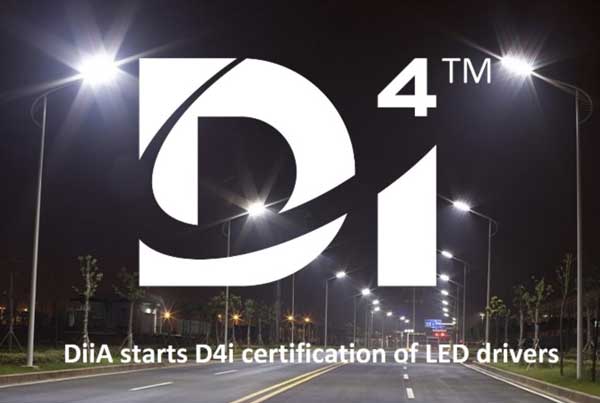
D4i is compatible with socketed connector systems that allow for the joint Zhaga-D4i program. Zhaga-D4i certification involves a combination of parts from Zhaga and D4i. This joint program enables smart, future-proof LED luminaires with IoT connectivity.

